For two tense weeks in July 2023, NASA feared humanity’s longest-running spacecraft might be lost forever. When a misdirected command on July 21 caused Voyager 2’s antenna to point just two degrees off target, communication with the most distant probe ever built was instantly severed. More than 12.3 billion miles from Earth, Voyager 2 fell silent. For NASA’s Jet Propulsion Laboratory, the prospect of losing this irreplaceable spacecraft felt entirely real, making what ought to have been a routine update one of the most nerve-wracking episodes in Voyager’s long career.
Category: 7. Science
-
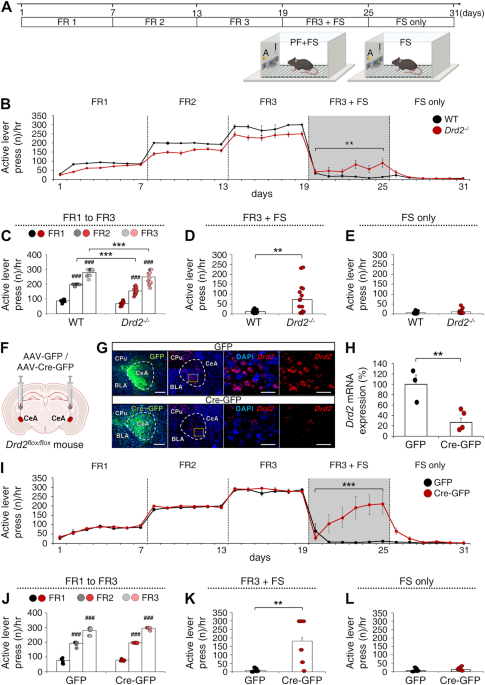
Dopamine D2 receptor modulation of insulin receptor signaling in the central amygdala: implications for compulsive-like eating behavior
Absence of D2Rs increases compulsive-like eating
We evaluated compulsive-like eating in wild-type (WT) and dopamine D2R knock-out (Drd2−/−) mice by employing a palatable food (PF) self-acquisition task. When a mouse pressed the active lever, a sucrose pellet (i.e., PF) was delivered. After 7 days, the number of lever presses required to obtain PF was increased, shifting from a fixed ratio of 1 (FR1) to FR2 and FR3 training schedules (Fig. 1A). Both groups successfully acquired lever pressing as the sessions progressed (Fig. 1B, C), although Drd2−/− mice displayed slightly less active lever pressing than WT mice across sessions, probably due to decreased locomotor activity in these mice [27]. During FR1 to FR3 sessions, both WT and Drd2−/− mice exhibited significantly increased active lever pressing than inactive lever press, demonstrating that the increase in lever pressing is specific to PF-seeking (Supplementary Fig. 1B–E).
Fig. 1: CeA D2Rs regulate compulsive-like eating. A Experimental scheme for food self-acquisition task. FR: fixed ratio, FS: foot shock (scrambled shock, 0.3 mA, 0.5 s), PF: palatable food, A: active lever, I: inactive lever. B Number of active lever presses per hour by WT and Drd2−/− mice across days. Two-way repeated measures ANOVA, group×session interaction: F3,78 = 4.77, **p = 0.0042. C Number of active lever presses per hour from FR1 to FR3 sessions. One-way ANOVA followed by Bonferroni post hoc tests, ###p < 0.001 vs. FR1, ***p < 0.001 vs. WT. D Number of active lever presses per hour in the last 3 days of FR3 + FS sessions. Unpaired Student’s t-test, two-tailed, **p = 0.0060. E Number of active lever presses per hour in FS only sessions. WT n = 12, Drd2−/− n = 16. F Schematic diagram of AAV-GFP or AAV-Cre-GFP injection into the CeA of Drd2flox/fox mice. G Left: Representative images of AAV-GFP and AAV-Cre-GFP virus expression in the CeA at low magnification. Virus expression was observed in three sections per mouse used for experiments. GFP control n = 3, Cre-GFP n = 4. Right: Drd2 mRNA expression in the CeA of GFP and Cre-GFP virus-injected mice as detected by FISH. Red: Drd2, green: GFP or Cre-GFP, blue: DAPI. Scale bar: low magnification, 100 μm, high magnification, 20 μm. H Quantitative analysis of Drd2 mRNA expression in the CeA. Proportion of Drd2 mRNA in GFP and Cre- GFP virus-injected mice. Unpaired Student’s t-test, two-tailed, **p = 0.0054. GFP control n = 3, Cre-GFP n = 4. I Number of active lever presses per hour by GFP and Cre-GFP virus-injected mice across days. Two-way repeated measures ANOVA, group×session interaction: F5,75 = 5.63, ***p = 0.0002. J Number of active lever presses per hour from FR1 to FR3 sessions. One-way ANOVA followed by Bonferroni post hoc tests, ###p < 0.001 vs. FR1. K Number of active lever presses per hour in the last 3 days of FR3 + FS sessions. Unpaired Student’s t-test, two- tailed, **p = 0.0033. L Number of active lever presses per hour in FS only sessions. GFP n = 8, Cre-GFP n = 6. All values in the data represent mean ± SEM.
After the FR3 sessions, additional FR3 sessions with delivery of electric foot shock (FS) were administered (FR3 + FS), and the perseverance of lever pressing to obtain PF despite the delivery of foot shocks was used as an indicator of compulsive-like food-seeking. Surprisingly, Drd2−/− mice exhibited significantly higher active lever pressing despite receiving foot shocks (Fig. 1B, D), showing perseverance in reward-seeking despite punishment. In contrast, WT mice exhibited significantly increased inactive lever press compared to active lever during FR3 + FS sessions (Supplementary Fig. 1F). When the rewards were omitted and only foot shocks were delivered (FS only), lever pressing was comparable between WT and Drd2−/− mice (Fig. 1B, E, Supplementary Fig. 1B, G), indicating similar sensitivity to foot shocks, but greater compulsivity in Drd2−/− mice, driving active lever pressing despite punishment. These data, together with previous observations [11], indicate that the absence of D2Rs promotes compulsive-like eating behavior.
CeA D2Rs regulate compulsive-like eating
To further address the role of D2Rs in the control of compulsive eating, we targeted D2Rs in the CeA based on our previous finding that CeA D2Rs play a crucial role in reward-related impulsive and compulsive behaviors [11]. We generated Drd2 flox/flox mice (Supplementary Fig. 2) and injected AAV-Cre-eGFP virus into the CeA to selectively eliminate D2R expression in the CeA (CeA-Drd2KO mice) (Fig. 1F), resulting in a 73% reduction in D2R expression in CeA-Drd2KO mice (Cre-GFP) compared with control flox mice in which AAV-eGFP virus was injected (CeA-Drd2WT, GFP) (Fig. 1G, H). We then trained mice in the PF self-acquisition task.
Both control (GFP) and CeA-Drd2KO (Cre-GFP) mice displayed successful FR1-FR3 performance with no difference between groups (Fig. 1I, J, Supplementary Fig. 3B–E). However, CeA-Drd2KO mice (Cre-GFP) showed more active lever pressing than CeA-Drd2WT mice (GFP) during the FR3 + FS sessions (Fig. 1I, K) while CeA-Drd2WT mice exhibited significantly increased inactive lever press compared to active lever during FR3 + FS sessions (Supplementary Fig. 3F). In FS-only sessions, both CeA-Drd2WT and CeA-Drd2KO mice showed low levels of lever pressing (Fig. 1I, L, Supplementary Fig. 3G). Taken together, these data suggest that D2Rs in the CeA critically contribute to the compulsive-like perseverance of PF-seeking behavior.
CeA D2Rs regulate InsR signaling
Recent reports indicate that InsRs are highly expressed in the CeA and are associated with reduced food intake [28,29,–30]. Using Drd2-EGFP mice, we observed abundant expression of InsRs in the CeA and found that ~61% of CeA D2R- expressing neurons co-expressed InsRs (Fig. 2A, B). Interestingly, in Drd2−/− mice, InsR expression was decreased to 42% in the CeA compared with WT mice (Fig. 2C, D). In addition, in CeA-specific Drd2 KO (CeA-Drd2KO) mice, InsR expression was reduced by ~60% compared with control CeA-Drd2WT mice (Fig. 2E–G).
Fig. 2: D2R and InsR expression in the CeA and regulation of InsR signaling by D2Rs. 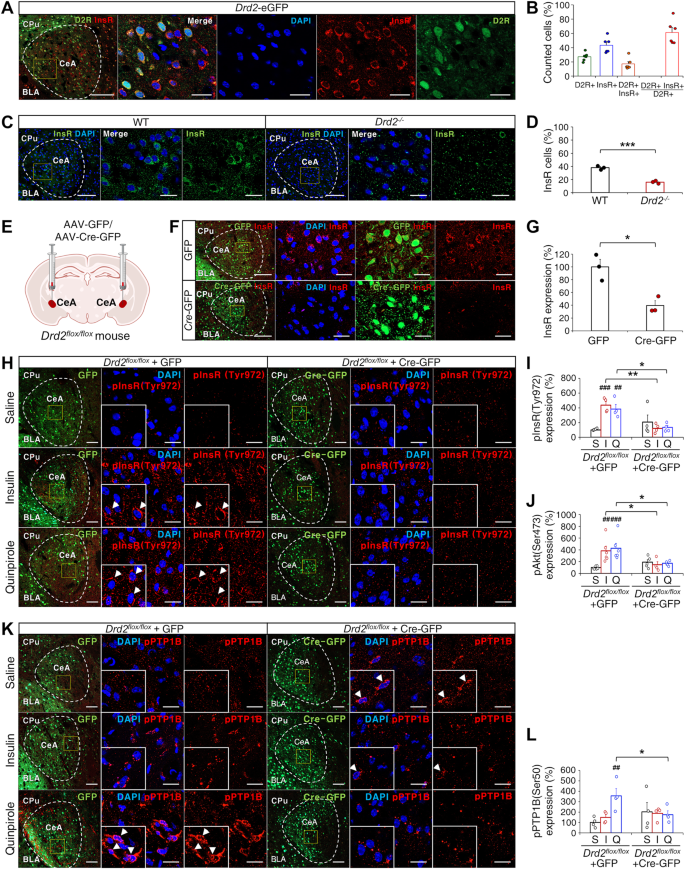
A D2R and InsR expression in the CeA of Drd2-eGFP mice. Left: Low magnification. Right: High magnification of area in the yellow box shown in the left. Red: InsR, green: Drd2-eGFP, blue: DAPI. B Quantitative analysis of D2R and InsR expression in the CeA of Drd2-eGFP mice. Drd2-eGFP n = 6 (8 sections/mouse). C InsR expression in the CeA of WT and Drd2−/− mice. Green: InsR, blue: DAPI. D Proportion of InsR-expressing cells in the CeA of WT and Drd2−/− mice. Unpaired Student’s t-test, two-tailed,***p = 0.0005. WT n = 3, Drd2−/− n = 3 (6sections/mouse). E Schematic diagram of AAV-GFP or AAV-Cre-GFP injection into the CeA of Drd2flox/flox mice. F Left: Representative images of GFP or Cre-GFP virus expression in the CeA in low magnification. Right: InsR expression in the CeA of GFP and Cre-GFP virus- injected mice as detected by immunohistochemistry. Red; InsR, Green: GFP or Cre-GFP, Blue: DAPI. Scale bar: low magnification, 100 μm, high magnification, 20 μm. G Quantitative analysis of InsR expression in the CeA. The proportion of InsR expression in GFP and Cre-GFP-injected Drd2flox/flox mice. Unpaired Student’s t-test, two-tailed, *p = 0.0123. GFP n = 3, Cre-GFP n = 3. H Expression of pInsRTyr972 with GFP or Cre-GFP-injected Drd2flox/flox mice. Saline/Insulin (10 mU)/quinpirole (1 µg) was infused 30 min before sacrifice. Left: low-magnification of the CeA of saline(S), insulin(I), or quinpirole(Q)-infused mice. Middle/Right: high-magnification of pInsRTyr972 expression in the CeA detected by immunohistochemistry. Quantitative analysis: three sections of one hemisphere/mouse, 4mice/group. Red: pInsRTyr972, Green: GFP/Cre-GFP, Blue: DAPI, Arrowhead: pInsRTyr972-positive cells. I pInsRTyr972 expression in the CeA of GFP or Cre-GFP-injected Drd2flox/flox mice. Two-way ANOVA, Bonferroni posthoc tests, group×drug interaction: F2,18 = 9.09, **p = 0.0019. GFP S/I/Q n = 4, Cre-GFP S/I/Q n = 4. J pAktSer473 expression in the CeA of GFP or Cre-GFP-injected Drd2flox/flox mice. Two- way ANOVA, Bonferroni posthoc tests, group×drug interaction: F2,26 = 5.66, **p = 0.0091, GFP S/I/Q n = 6, Cre-GFP S/Q n = 5, Cre-GFP I n = 4. K Expression of pPTP1BSer50 in CeA of GFP/Cre-GFP-injected Drd2flox/flox mice. Quantitative analysis: three sections of one hemisphere/mouse, n=4mice/group. Red: pPTP1B, Green: GFP/Cre-GFP, Blue: DAPI, Arrowhead: pPTP1B-positive cells. L pPTP1BSer50 expression. Two-way ANOVA,Bonferroni posthoc tests, group×drug interaction: F2,18 = 5.13, *p = 0.0173, GFP S/I/Q n = 4, Cre-GFP S/I/Q n = 4. Scale bars in all images: low-magnification, 100μm, high-magnification, 20μm. All values in the data represent mean ± SEM.
We next examined InsR activity by assessing insulin-mediated phosphorylation of InsRs in the CeA of CeA-Drd2WT (Drd2flox/flox + GFP) and CeA- Drd2KO (Drd2flox/flox+Cre-GFP) mice as well as the possible regulation of InsR phosphorylation by a D2R agonist. We analyzed phosphorylation of Tyr-972 (pInsRTyr972), an important residue for the recruitment of IRS-1, phosphorylation of Tyr1162/1163 (pInsRTyr1162/1163) in the activation loop of the InsR catalytic domain [31, 32], and phosphorylation of Akt (pAktSer473) in the downstream InsR signaling cascade [32]. After 12 h of food deprivation, saline, insulin (10 mU), or D2R agonist quinpirole (1 μg) were infused into the CeA. A robust increase in the number of pInsRTyr972-positive cells was observed 30 min after insulin or quinpirole infusion in CeA-Drd2WT mice (Drd2flox/flox + GFP), whereas CeA-Drd2KO mice (Drd2flox/flox+Cre-GFP) showed higher basal levels of pInsRTyr972-positive cells, but no increase after insulin or quinpirole infusion (Fig. 2H, I, Supplementary Fig. 4A). Insulin or quinpirole infusion significantly increased the number of pInsRTyr1162/1163-positive cells in the CeA of CeA-Drd2WT mice (GFP). By contrast, CeA-Drd2KO mice (Cre-GFP) showed a higher basal level of pInsRTyr1162/1163-positive cells, but insulin or quinpirole infusion had little or no effect on their levels (Supplementary Fig. 4B, D, E). Insulin or quinpirole infusion significantly increased the number of pAKTSer473-positive cells in the CeA of CeA-Drd2WT mice but not in CeA-Drd2KO mice (Fig. 2J, Supplementary Fig. 4C, D).
To understand how the D2R activation induces the tyrosine phosphorylation of InsRs, we hypothesized that D2R activation with Gi protein coupling promotes the phosphorylation of InsRs. Several studies demonstrate that the cAMP-inhibiting Gi proteins, including Gαi2, positively regulate InsR activation [33,34,35,–36]. By contrast, the expression and activity of protein-tyrosine phosphatase 1B (PTP1B) is decreased in tissue expressing constitutively active Gαi2 [37]. We examined the involvement of PTP1B by analyzing the phosphorylation level of PTP1B at Ser50 (pPTP1BSer50), which negatively modulates its phosphatase activity, thus creating a positive feedback mechanism for insulin signaling [38]. We observed that D2R activation by quinpirole significantly increased the number of pPTP1BSer50-positive cells in CeA-Drd2WT (Drd2flox/flox + GFP) mice, whereas insulin or quinpirole infusion had little or no effect on number of pPTP1BSer50-positive cells in CeA-Drd2KO mice (Drd2flox/flox+Cre-GFP) (Fig. 2K, L and Supplementary Fig. 4F). These data suggest that D2R activation induces PTP1B inhibition and impairs its ability to dephosphorylate InsRs, leading to increased insulin signaling. Thus, the stimulation of CeA D2Rs may induce concomitant activation of InsR signaling in the CeA, and the absence of D2Rs severely impairs InsR signaling.
CeA InsRs impact compulsive-like eating
We next tested the effect of selective loss of InsR expression in CeA D2R- expressing neurons on compulsive-like eating behavior. To accomplish this, we used a gene knockdown strategy with Cre-dependent AAV vectors expressing a short-hairpin RNA (shRNA) targeting InsRs to induce cell type-specific loss of function while simultaneously visualizing recombination through mCherry labeling using AAV-DIO-DSE-mCherry-PSE-shInsR [39]. Selective expression of shInsR in D2R- expressing neurons in the CeA (CeA-D2RshInsR) resulted in an ~80% reduction in InsR expression compared with control mice in which AAV-DIO-eYFP was injected (CeA-D2ReYFP) (Fig. 3A–C). We found that D2R-specific loss of InsRs in the CeA exacerbated compulsive-like eating phenotype, as evidenced by robust perseverance of active lever pressing despite foot shock punishment (Fig. 3D–F, Supplementary Fig. 5B–F). In FS-only sessions, no difference in lever pressing was observed between control and CeA-D2RshInsR mice (Fig. 3D, G, Supplementary Fig. 5G). Together, these data suggest that InsRs and the interaction between InsRs and D2Rs in the CeA are critical for the control of compulsive-like eating behavior.
Fig. 3: Selective loss of InsRs in CeA D2R-expressing neurons results in stronger compulsive-like perseverance of PF-seeking behavior. 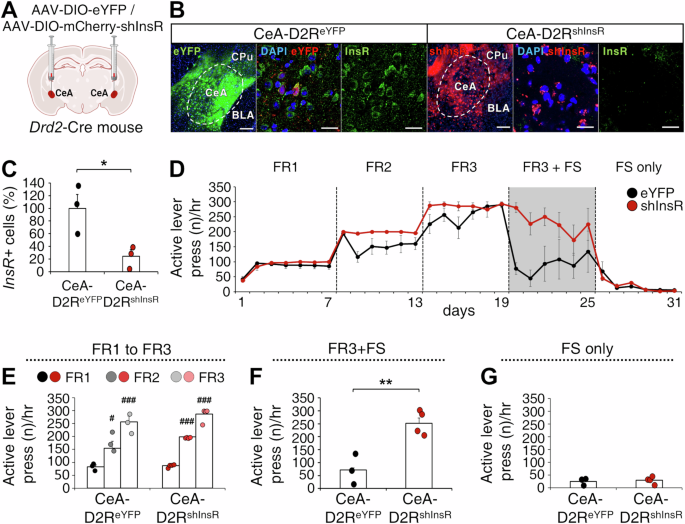
A Schematic diagram of AAV-DIO-eYFP or AAV-DIO-DSE-mCherry-PSE-shInsR injection into the CeA of Drd2-Cre mice. B Representative InsR expression in the CeA of CeA-D2ReYFP control and CeA-D2RshInsR mice. Virus expression was observed in three sections per mouse used for experiments. CeA-D2ReYFP n = 3, CeA-D2RshInsR n = 3. Red: eYFP or shInsR, green: InsR, blue: DAPI. Scale bar: low magnification, 100 μm, high magnification, 20 μm. C Quantitative analysis of InsR expression in the CeA of CeA-D2ReYFP control and CeA-D2RshInsR mice. CeA-D2ReYFP n = 3, CeA-D2RshInsR n = 3. Unpaired student’s t-test, two-tailed, *p = 0.0344. D Number of active lever presses per hour by CeA-D2ReYFP and CeA-D2RshInsR mice across days. CeA-D2ReYFP n = 3, CeA-D2RshInsR n = 4. E Number of active lever presses per hour in FR1 to FR3 sessions. One-way ANOVA followed by Bonferroni post hoc tests, #p < 0.05, ###p < 0.001 vs. FR1. CeA-D2ReYFP n = 3, CeA-D2RshInsR n = 4. F Number of active lever presses per hour in the first 3 days of FR3 + FS sessions. Unpaired Student’s t-test, two-tailed, **p = 0.0061. CeA-D2ReYFP n = 3, CeA- D2RshInsR n = 4. G Number of active lever presses per hour in FS only sessions. CeA-D2ReYFP n = 3, CeA-D2RshInsR n = 4. All values in the data represent mean ± SEM.
PF and insulin modulate CeA D2R-expressing neuronal activity
To understand how CeA D2R-expressing neurons respond to PF, we used fiber photometry to perform in vivo calcium imaging. We virally expressed the Cre- dependent calcium indicator GCaMP6s (AAV-DIO-GCaMP6s-mCherry) in the CeA of Drd2-Cre mice (Fig. 4A) and recorded changes in GCaMP6s fluorescence signal through an optic fiber placed above CeA D2R-expressing neurons during exposure to PF in a light/dark box test. Histological analysis revealed that ~96% of GCaMP6-expressing cells overlapped with Cre-expressing CeA D2R-expressing cells (Fig. 4B, C). After measuring baseline body weight and food intake, mice underwent a pre-test without food for 15 min to measure their time spent in the light and dark chambers of the light/dark box [11]. Mice were then divided into two groups: one group was fed a NC diet, and the other group was fed a PF diet high in sugar and fat ad libitum for 14 days. After a 48-h PF withdrawal, mice were returned to the light/dark box for 15 min, with PF placed in the light chamber, to assess compulsive-like eating behavior [11], during which we recorded GCaMP signals from CeA D2R-expressing neurons (Fig. 4D). As shown by peri-event time histogram (PETH) analysis, there was a significant decrease in z-score (i.e., normalized ΔF/F) during PF consumption (Fig. 4E, G), whereas no significant change in GCaMP signal was observed during exposure to NC (Fig. 4E, F), indicating a decrease in CeA D2R-expressing neuronal activity in response to PF. This suppression was accompanied by increased PF intake in the light chamber, supporting a link between reduced D2R neuron activity and compulsive-like eating behavior (Fig. 4H).
Fig. 4: PF modulates CeA D2R neuronal activity. 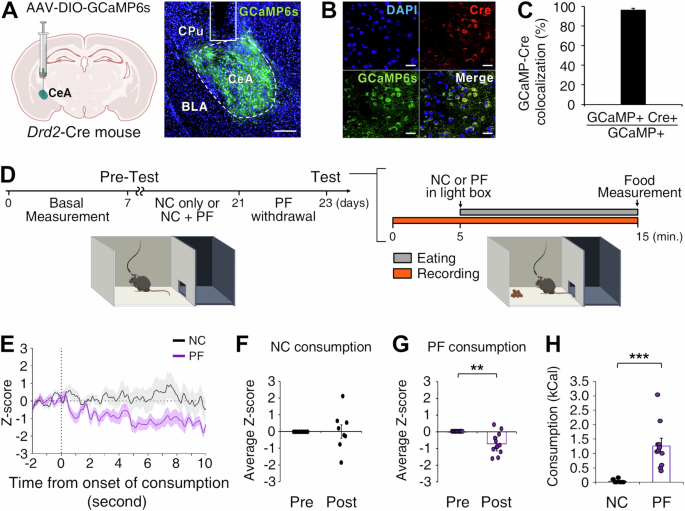
A Left: diagram of AAV-DIO- GCaMP6s injection into the CeA of Drd2-Cre mice. Right: Representative images of AAV-DIO-GCaMP6s virus expression in the CeA at low magnification. Virus expression was observed in three sections per mouse. Scale bar: 100 μm. Drd2– Cre n = 3. B Colocalization of Cre- and GCaMP6s-positive cells in the CeA. Red; Cre, green; GCaMP6s, blue; DAPI. Scale bar: 20 μm. C Quantification of Cre- and GCaMP6s-positive cells in the CeA of three Drd2-Cre mice. D Experimental scheme of the light/dark box test with fiber photometry. NC; normal chow, PF; palatable food. E Normalized z-score during NC and PF consumption. F Average z-score pre- ( − 2 to 0 s) and post- (0 to +10 s) NC consumption. Drd2-Cre n = 8. G Average z-score pre (-2s to 0 s) and post (0 s to +10 s) PF consumption. Drd2-Cre n = 12. Paired student’s t-test, two- tailed, *p = 0.0023. H Food consumption for 10 min. Drd2-Cre NC n = 7, Drd2-Cre PF n = 11. Unpaired student’s t-test, two-tailed, ***p = 0.0007. All values in the data represent mean ± SEM.
We next recorded changes in the GCaMP6s signal from CeA D2R-expressing neurons during exposure to PF in the light/dark box test after infusion of saline, quinpirole, insulin, quinpirole+insulin, or the D2 receptor antagonist sulpiride into the CeA (Fig. 5A). Under saline infusion, CeA D2R neurons exhibited significantly reduced activity during PF consumption (Fig. 5B, C), consistent with the dynamics observed in Fig. 4E, and G. Quinpirole or insulin infusion, also induced significant reductions in z-scores during PF consumption (Fig. 5D–F) which was accompanied by a reduction in PF consumption (Fig. 5D–F, L). However, when quinpirole and insulin were co-infused, the suppression of neuronal activity was alleviated (Fig. 5D, G, L) corresponding to reduced PF consumption. In contrast, sulpiride infusion resulted in a significant suppression of neuronal activity and an increase in PF consumption (Fig. 5H, I, L), while its effect was slightly reversed by quinpirole (Fig. 5H, J, L) and fully alleviated by quinpirole+insulin, which also reduced PF consumption (Fig. 5H, K, L). These data indicate that D2R activation in the presence of insulin effectively enhances CeA D2R-expressing neuronal activity, thereby contributing to the suppression of PF consumption.
Fig. 5: PF and Insulin modulate CeA D2R neuronal activity. 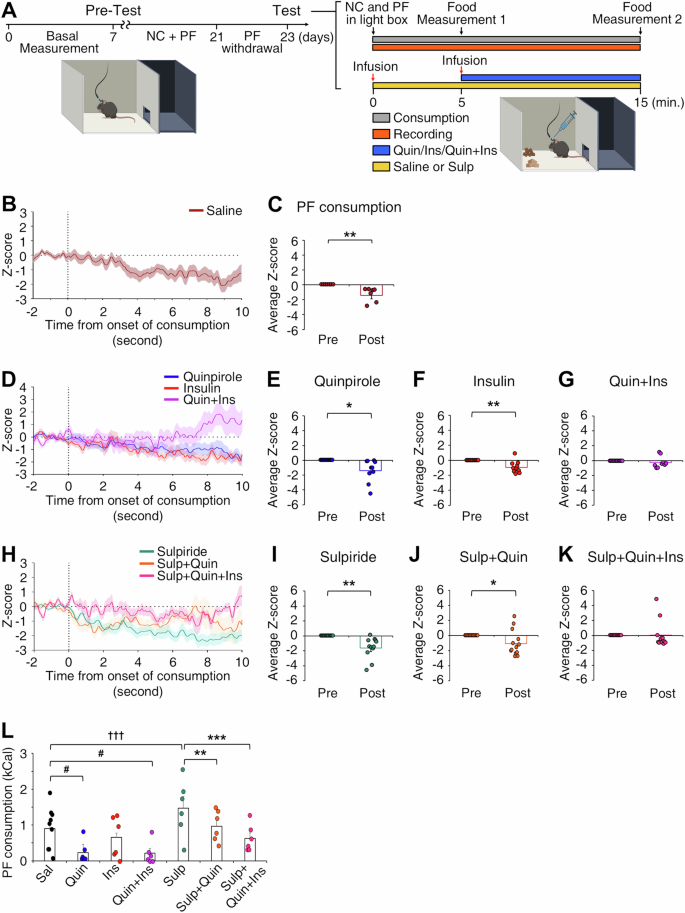
A Experimental scheme of light/dark box test and fiber photometry with drug infusion. B Normalized z-score during PF consumption after saline infusion. C Average z-score during PF consumption after saline infusion. Saline: Drd2-Cre n = 7. Paired student’s t-test, two-tailed, **p = 0.0095. D Normalized z-score during PF consumption after quinpirole (1 µg), insulin (5 mU), or quinpirole+insulin infusion. E-G Average z-score during PF consumption after drug infusion. E Quinpirole: Drd2-Cre n = 10. Paired student’s t-test, two-tailed, *p = 0.0153. F Insulin: Drd2-Cre n = 10. Paired student’s t-test, two-tailed, **p = 0.0045. G Quin+Ins: Drd2-Cre n = 9. Paired student’s t-test, two-tailed, p = 0.3200. H Normalized z-score during PF consumption after sulpiride (1 µg), sulpiride+quinpirole, or sulpiride+quinpirole+insulin infusion. I-K Average z-score on pre (-2s to 0 s) and post (0 s to +10 s) during PF consumption after drug infusion. I Sulpiride: Drd2-Cre n = 12. Paired student’s t-test, two-tailed, **p = 0.0021. J Sulp+Quin: Drd2-Cre n = 13. Paired student’s t-test, two-tailed, *p = 0.0442. K Sulp+Quin+Ins: Drd2-Cre n = 11. Paired student’s t-test, two-tailed, p = 0.8766. L PF consumption for 10 min. in drug-infused mice. Saline, Quinpirole, Insulin, Quin+Ins Drd2-Cre n = 13. Repeated measure One-way ANOVA, Bonferroni posthoc tests **p = 0.0048, #p < 0.05 vs. saline. Sulpiride, Sulp+Quin, and Sulp+Quin+Ins Drd2– Cre n = 13. Repeated measure One-way ANOVA, Bonferroni posthoc tests, ***p = 0.0002, †††p < 0.001 vs. saline, **p < 0.01, ***p < 0.001 vs. group. Solid line: average z-score of food consumption. Shaded line: standard error of the mean. All values in the data represent mean ± SEM.
We further explored the effect of insulin on CeA D2R neuronal activity by ex vivo electrophysiological recordings in brain slices from Drd2-EGFP mice. Bath application of quinpirole alone (10 µM) failed to significantly change the membrane excitability of D2R-expressing CeA neurons (Supplementary Fig. 6A–E). CeA D2R neurons did not show significant changes in rheobase or membrane potential. However, when co-treated with insulin (500 nM), quinpirole dramatically depolarized their resting membrane potential and increased their excitability, as shown by decreased rheobase and enhanced input resistance (Supplementary Fig. 6C–E). When insulin alone was perfused into the recording chamber, it significantly hyperpolarized the resting membrane potential of CeA D2R neurons and decreased their firing probabilities by increasing rheobase and reducing input resistance (Supplementary Fig. 6F–J). These ex vivo electrophysiological studies suggest that the activation of D2Rs and InsRs has a synergistic effect that substantially increases the excitability of D2R neurons in the CeA. Furthermore, this interaction may be critical for the regulation of compulsive-like eating behavior, supporting our GCaMP6s photometry analysis following quinpirole or insulin infusion.
Next, we examined the effect of selective optogenetic inhibition of CeA D2R-positive neurons expressing halorhodopsin in the CeA of Drd2-Cre mice by injecting AAV-DIO-eNpHR3.0-eYFP virus (Fig. 6A, B) and conducted the light/dark box test (Fig. 6C–H). Bilateral photoinhibition of CeA D2R neurons resulted in a significant and specific increase in palatable food consumption in the light compartment (Fig. 6G, H and Supplementary Video 1). We further tested whether InsR signaling contributes to the regulation of CeA D2R-mediated PF consumption by selectively activating CeA D2R neurons. To this end, we injected AAV-DIO-eYFP (eYFP) or AAV-DIO-ChR2-eYFP (ChR2) into the CeA of Drd2-Cre mice followed by CeA infusion of the InsR antagonist S961 (Supplementary Fig. 7, Supplementary Fig. 8A, B). Mice underwent the light/dark box test, and pre-test evaluations revealed no differences in basal body weight, food intake, or light/dark box preference between groups expressing eYFP (control) or ChR2 in CeA D2R neurons (Supplementary Fig. 8C–F). Following this, the mice were divided into two groups: one group was maintained on a NC diet, while the other was provided with PF for 14 days. Afterward, mice were reintroduced to the light/dark box for a 25-minute test, with PF placed in the light compartment. Fifteen minutes before testing, mice received CeA infusions of either saline or S961.
Fig. 6: Inhibition of CeA D2R neuronal activity enhances compulsive-like eating behavior. 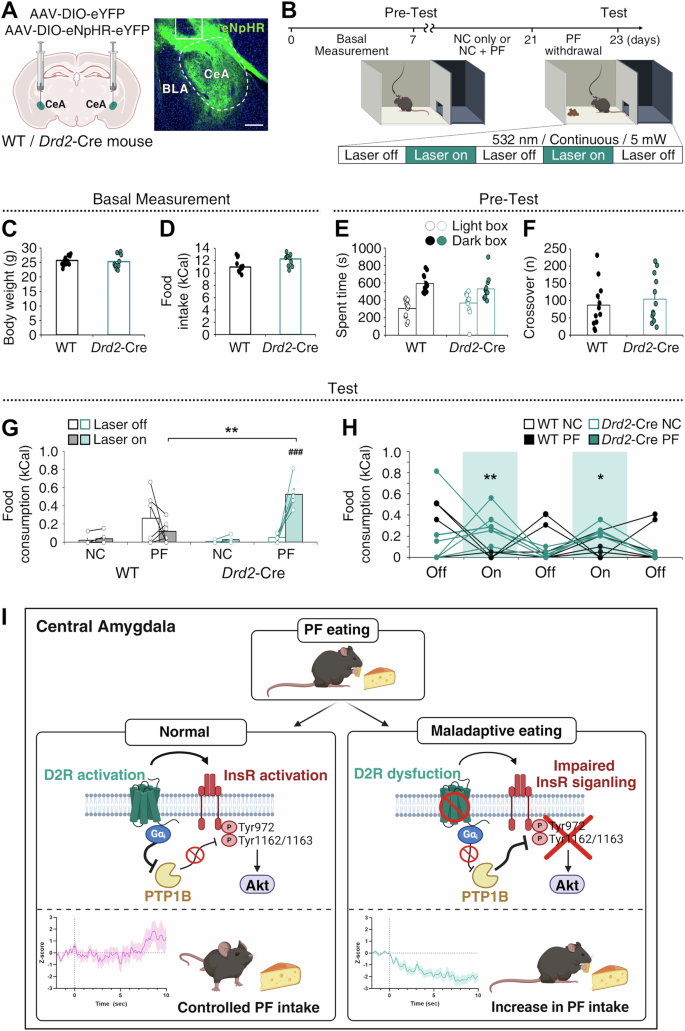
A Diagram of AAV-DIO-eNpHR3.0-eYFP injection into the CeA. B Experimental scheme of light/dark box test using optogenetic inhibition. Optic stimulation: 532 nm, 5 mW, continuous. C-D Basal body weight and food intake for 1 week. E-F Time spent in each box and the number of crossovers during 15-min pre-test. G Food consumption in light box during 10-min total laser-off and -on periods. Two- way ANOVA, Bonferroni post hoc tests, genotype × laser interaction: F1,20 = 18.86, p = 0.0003, **p < 0.01 vs. WT, ##p < 0.01 vs. laser-off. H Time course of food consumption in laser-off and -on 5-min periods. Green shaded-square: laser-on period. Unpaired student’s t-test, two-tailed, *p = 0.0261, **p = 0.0019. WT NC/PF n = 6, Drd2-Cre NC n = 5, PF n = 6. All values in the data represent mean ± SEM. I proposed interplay between D2Rs and InsRs in the CeA. A decrease in CeA D2R-expressing neuronal activity is associated with palatable food (PF) consumption. Activation of D2R induces InsR phosphorylation via Gi protein coupling and PTP1B inhibition as demonstrated in this study. The synergistic activation of D2Rs and InsRs enhances CeA D2R-expressing neuron activity, thereby controlling PF intake. Conversely, loss or blockade of D2Rs disrupts InsR signaling, leading to reduced CeA D2R-expressing neuron activity and increased PF consumption. Therefore, proper coordination between D2R and InsR signaling is critical for fine-tuning brain insulin sensitivity and managing normal or maladaptive eating behavior.
In the PF-fed group, optogenetic activation of CeA D2R neurons significantly suppressed PF consumption in ChR2-expressing mice. However, this suppression was abolished when S961 was infused into the CeA, demonstrating that InsR signaling is necessary for CeA D2R-mediated regulation of compulsive-like PF consumption (Supplementary Fig. 8G, H). These findings indicate that CeA D2R neurons, in conjunction with InsR signaling, are critical for modulating compulsive-like eating behavior specific to PF. In the NC group, however, optogenetic activation of CeA D2R neurons had no effect on NC consumption, even after six hours of food deprivation prior to testing. Furthermore, S961 infusion did not alter NC consumption in either eYFP control or ChR2-expressing mice (Supplementary Fig. 8G, H). Together, these data indicate that reduced CeA D2R-expressing neuronal activity is associated with increased PF consumption whereas activation of CeA D2R neurons suppresses compulsive-like eating in an InsR-dependent manner (Fig. 6I).
DA release during PF consumption and its modulation by CeA D2R knockdown
Next, we examined changes in DA release in the CeA in response to PF using the genetically encoded fluorescence DA sensor GRAB-DA2m [40]. We prepared two groups of Drd2-Cre mice: one receiving AAV- DIO-DSE-mCherry-PSE-shLacZ in the CeA as a control (shLacZ) and the other receiving AAV- DIO-DSE-mCherry-PSE-shD2R (shD2R) for selective D2R knockdown in CeA D2R neurons (Supplemental method). Selective expression of shD2R in D2R-expressing CeA neurons resulted in a ~ 77% reduction in D2R expression compared to the control group injected with shLacZ (Supplementary Fig. 9A–C). Both groups were injected with AAV-hSyn-GRAB_DA2m viruses bilaterally into the CeA and a fiber optic cannula was implanted unilaterally to enable real-time measurement of DA levels during PF-seeking behavior (Supplementary Fig. 9A, D). After one week of NC access, there was no significant difference in the GRAB signal between the shLacZ and shD2R mice (Supplementary fig. 9F, G). Subsequently, mice were randomly assigned to two groups: one with limited PF access (1 hr/day, PF limited) and the other with extended PF access (24 hr/day, PF extended) for two weeks (Supplementary Fig. 9D). In the PF-limited condition, shD2R mice consumed approximately 64% of their daily caloric intake during the 1-hour PF access period, significantly more than shLacZ mice, despite similar overall daily caloric intake between groups. This behavior indicates binge-like eating in shD2R mice with CeA D2R downregulation (Supplementary Fig. 9E). In the PF-extended condition, both groups displayed similar daily caloric intakes, derived almost exclusively from PF consumption (Supplementary Fig. 9E). In terms of body weight, PF-extended shD2R mice showed a slight, non-significant increase compared to shLacZ mice (Supplementary Fig. 9F).
After two weeks of PF exposure, DA release profiles during PF consumption were similar between shLacZ and shD2R mice in the PF-limited condition. However, in the PF-extended condition, shD2R mice exhibited a blunted DA signal in the CeA compared to shLacZ controls (Supplementary Fig. 9I–L), These findings indicate that CeA D2R deficiency leads to attenuated DA release under prolonged PF exposure, emphasizing the importance of CeA D2R in modulating reward-related DA signaling.
Continue Reading
-
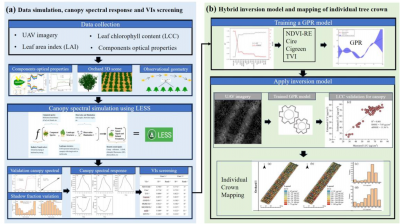
UAV imaging and AI model overcome canopy shadow challenge in apple orchards
Leaf chlorophyll content (LCC) and canopy chlorophyll content (CCC) are widely used indicators of photosynthetic capacity, nitrogen status, and overall plant health. Accurate monitoring of chlorophyll content in apple leaves and canopies is essential for optimizing orchard management and advancing smart agriculture. Traditional chemical assays to measure chlorophyll are destructive and impractical for large-scale application. Remote sensing techniques, especially vegetation indices (VIs), have emerged as alternatives, yet their accuracy is highly sensitive to shadows within canopies. While satellite-based methods often ignore shadow effects due to coarse resolution, UAVs provide centimeter-level imagery where shadows become prominent and problematic. Conventional approaches attempt to mask shadowed pixels, but this introduces new uncertainties. Therefore, developing shadow-resistant methods is a key step toward reliable chlorophyll monitoring in modern precision orchards.
A study (DOI: 10.1016/j.plaphe.2025.100015) published in Plant Phenomics on 6 March 2025 by Hao Yang’s team, Beijing Forestry University, establishes a shadow-resistant UAV and modeling framework that enables accurate chlorophyll monitoring of individual apple trees, advancing precision management in modern smart orchards.
In this study, researchers combined three-dimensional radiative transfer modeling (3D RTM), UAV-based multispectral imagery, and Gaussian process regression (GPR) to overcome the effects of canopy shadows on chlorophyll estimation in apple orchards. First, the accuracy of simulated canopy reflectance was validated against field measurements, showing nearly identical spectral curves (R² = 0.999, RMSE = 0.03), confirming the reliability of the simulated spectra for subsequent analyses. Simulations revealed that the proportion of canopy shadows followed a parabolic pattern over the day, with the lowest shadow fraction and highest photon escape probability at noon, making midday the optimal time for UAV data collection. Spectral analysis further demonstrated that visible band reflectance peaked when shadows were minimal, whereas near-infrared reflectance exhibited the opposite trend. Next, the team assessed the resistance of vegetation indices (VIs) to shadow interference, ranking them by robustness. Five indices—NDVI-RE, Cire, Cigreen, TVI, and GNDVI—were identified as least sensitive to shadow variations, and four of them (NDVI-RE, Cire, Cigreen, and TVI) were sufficient to achieve the highest inversion accuracy. Comparisons between simulated and UAV-measured VIs confirmed consistency, validating the use of simulated datasets to support modeling. Based on these insights, a hybrid inversion model was developed that integrated selected VIs with GPR. The model performed well, with LCC estimates reaching R² = 0.78 and RMSE of 6.86 μg/cm², and CCC estimates achieving R² = 0.78 and RMSE of 32.33 μg/cm². Importantly, the model provided comparable or superior results to traditional shadow-masking approaches while avoiding their limitations. Finally, mapping across two orchards (429 and 215 trees) revealed significant spatial heterogeneity in both LCC and CCC, with values showing normal distributions, underscoring the method’s ability to capture fine-scale variability in canopy chlorophyll content for individual apple trees.
This shadow-resistant inversion method has immediate applications in smart orchard management. By providing accurate, non-destructive chlorophyll data at the individual tree level, growers can detect nutrient deficiencies, monitor stress, and optimize fertilizer use with unprecedented precision. The approach reduces dependence on destructive sampling and overcomes the limitations of masking algorithms, offering a scalable solution for large orchards. Moreover, mapping CCC and LCC distributions enables managers to visualize variability within orchards, supporting site-specific interventions that improve productivity, sustainability, and resource efficiency.
###
References
DOI
10.1016/j.plaphe.2025.100015
Original URL
https://doi.org/10.1016/j.plaphe.2025.100015
Funding information
This research was funded by the Natural Science Foundation of China (42171303, 42371373) and the Special Fund for Construction of Scientific and Technological Innovation Ability of Beijing Academy of Agriculture and Forestry Sciences (KJCX20230434).
About Plant Phenomics
Science Partner Journal Plant Phenomics is an online-only Open Access journal published in affiliation with the State Key Laboratory of Crop Genetics & Germplasm Enhancement, Nanjing Agricultural University (NAU) and distributed by the American Association for the Advancement of Science (AAAS). Like all partners participating in the Science Partner Journal program, Plant Phenomics is editorially independent from the Science family of journals. Editorial decisions and scientific activities pursued by the journal’s Editorial Board are made independently, based on scientific merit and adhering to the highest standards for accurate and ethical promotion of science. These decisions and activities are in no way influenced by the financial support of NAU, NAU administration, or any other institutions and sponsors. The Editorial Board is solely responsible for all content published in the journal. To learn more about the Science Partner Journal program, visit the SPJ program homepage.
Continue Reading
-

India-US advanced Earth observation satellite NISAR completes tests, ready to beam scientific data
The NASA-ISRO Synthetic Aperture Radar (NISAR) Earth-observing radar satellite mission, has completed its tests in orbit and is now on track to start beaming scientific data back to ground stations.
“The mission team anticipates having science-quality radar images in the coming weeks. Full science operations have been scheduled to begin about 90 days after launch,” it added.
Continue Reading
-

Key to cutting food waste is in our daily routines
Every day, huge amounts of food go straight into the trash. Governments try new policies, supermarkets run campaigns, and restaurants push subtle nudges. Yet, waste piles up. Families still throw away edible meals while millions go hungry.
Researchers at the University of Portsmouth decided to ask a simple question: Do quick reminders like “save” or “reuse” actually change anything? Their answer points in a very different direction. Instead of being swayed by short messages, people’s long-term habits mattered most.
Those who already valued frugality wasted less food, while others hardly changed. The study shows lasting behavior change needs deeper roots.
Frugal cues shaped food choices
Priming works by slipping subtle hints into people’s surroundings, shaping their decisions without much thought. A word like “reuse” on a menu or an image of a savings box can act as a signal. To test this, researchers worked with 95 participants.
Some received frugal prompts, while others saw materialistic ones. Then came the task: deciding whether to keep or discard food items at different stages of freshness.
The aim was to see if quick cues could change behavior in the moment. Would frugal prompts encourage saving food, or would deeper, long-term habits prove more influential in avoiding waste?
The results leaned heavily toward habits. People who already had a frugal outlook tended to waste less, regardless of the cues. In contrast, those with weaker frugal tendencies were more easily swayed, especially by materialistic signals that emphasized abundance and consumption.
This suggested that prompts alone were not enough. Without strong values in place, cues could even push some people toward more waste. For real impact, the study showed, consistent habits and ingrained mindsets mattered far more than momentary signals.
The psychology of prompts
The results were striking. People with strong frugal habits wasted less food, no matter the prompts. Those habits had more influence than any word or image.
Materialistic cues did push less frugal people to waste more. But participants who already lived frugally resisted the pull. Their everyday mindset acted like a shield.
This shows that strong values can override outside influences. When frugality becomes second nature, people stay consistent even when surrounded by messages promoting excess and consumption.
“Our findings suggest that quick nudges and priming cues are not enough to shift food waste behavior,” said Steven Iorfa, lead author and Ph.D. student at the University of Portsmouth. “It’s people’s ingrained, everyday frugal habits that make the real difference.”
Food waste fuels global crisis
Food waste is more than an inconvenience, it’s a crisis. One-third of all food produced never gets eaten, even while billions of people struggle with hunger. In 2023, more than 2.3 billion people faced food insecurity, and that number could rise as the population grows.
By 2050, nearly 10 billion people will need food, yet our current system already wastes too much. Reducing waste is not just about saving money or cleaning plates, it’s about survival.
Every meal saved means fewer resources wasted, less pressure on the environment, and more food reaching those who truly need it.
The findings suggest that posters, slogans, or quick nudges are not enough. What works is building frugality into daily life. People who plan meals, reuse ingredients, and avoid unnecessary purchases already save more food without thinking about it.
Researchers point to education and community programs as better paths. Teaching young people to cook with leftovers, showing families how to budget, and framing frugal shopping as “smart shopping” could help.
Schools could include lessons on food planning, while local initiatives might run workshops that connect frugality with sustainability and community well-being.
“Frugality is more than a budgeting tactic,” said Iorfa. “It’s a mindset that encourages people to see waste as inconsistent with their values. If we want lasting change, we need to promote frugality as a social norm, not just rely on one-off prompts.”
Frugality ensures future food
Cutting food waste requires more than quick reminders or catchy slogans. Lasting change depends on habits that shape daily choices.
When people build routines like meal planning, reusing leftovers, and shopping mindfully, waste naturally decreases. Societies that value resourcefulness over abundance create environments where these habits thrive.
By shifting focus from one-time campaigns to long-term cultural norms, communities can resist wasteful influences and encourage mindful consumption.
This shift is not only about saving money but also about protecting resources and ensuring food security for billions. True progress comes from making frugality a shared, everyday practice across generations.
The study is published in the journal Food Quality and Preference.
—–
Like what you read? Subscribe to our newsletter for engaging articles, exclusive content, and the latest updates.
Check us out on EarthSnap, a free app brought to you by Eric Ralls and Earth.com.
—–
Continue Reading
-
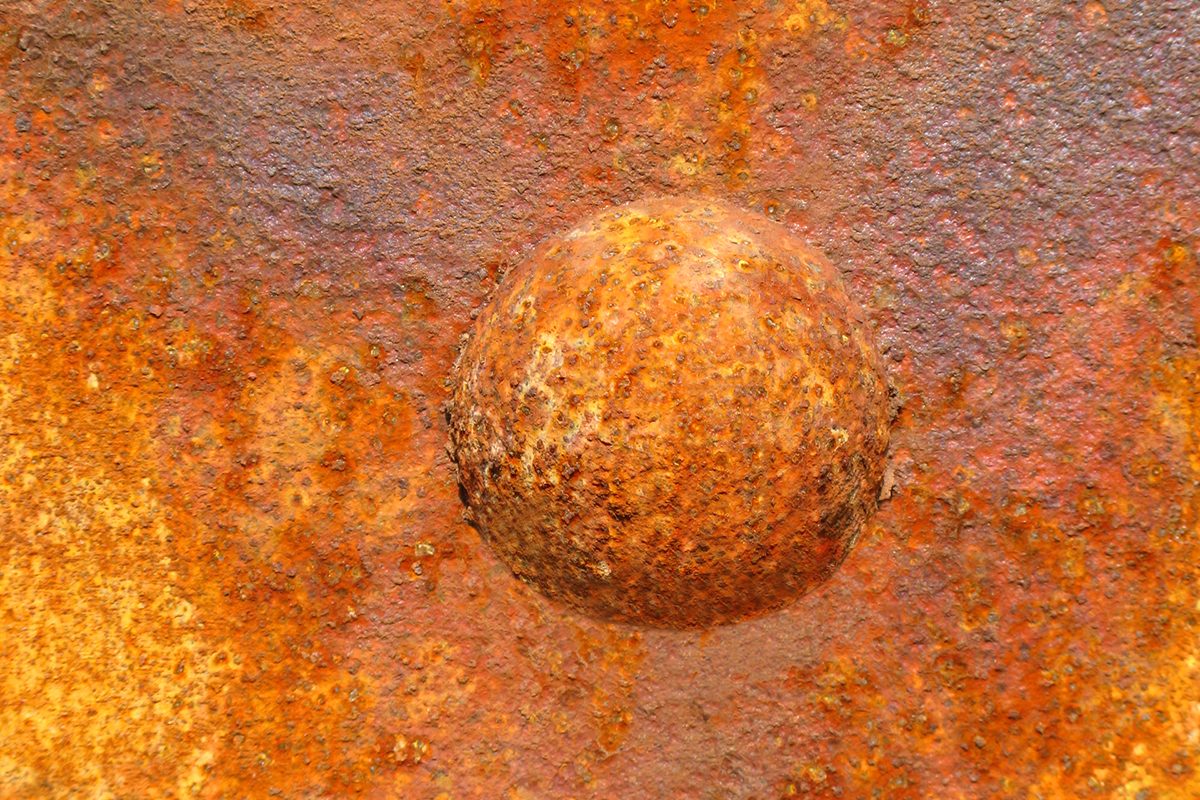
Thanks to Earth, the Moon may be slowly rusting, and it gets worse around full Moon
Get the key facts about this story in our quick 1-minute read
- Unexpected discovery: Despite lacking air and water, scientists detected hematite – a form of rust – on the Moon in 2020 via data from India’s Chandrayaan-1 mission
- Rust needs iron, oxygen, and water: While Moon rocks are rich in iron, the necessary oxygen and water shouldn’t be available, making this discovery puzzling
- Earth’s magnetic tail: Earth’s magnetic field stretches into space and forms a ‘tail’ that the Moon passes through for about six days each lunar cycle, near full Moon
- Borrowed oxygen: During those periods, Earth’s oxygen may hitch a ride along the magnetotail to the Moon, supplying the oxygen required for rust formation
- Solar wind protection: Earth’s magnetotail also blocks most of the solar wind’s hydrogen (a reducer that prevents rust) during full Moon, creating a rare window for oxidation
- Moon’s water: Though there’s no liquid water, water molecules and hydroxyl detected on the lunar surface (especially at the poles) could offer the moisture needed for rust to form
- Dust plays a role: Micrometeorite impacts may release or bring water molecules into contact with iron, helping trigger the rusting reaction when conditions align
- Mystery remains: This model explains why rust appears mainly on the near side facing Earth, but minor rust on the far side remains unexplained, and needs more data
Credit: ISRO/NASA/JPL-Caltech/Brown Univ./USGS Continue Reading
-
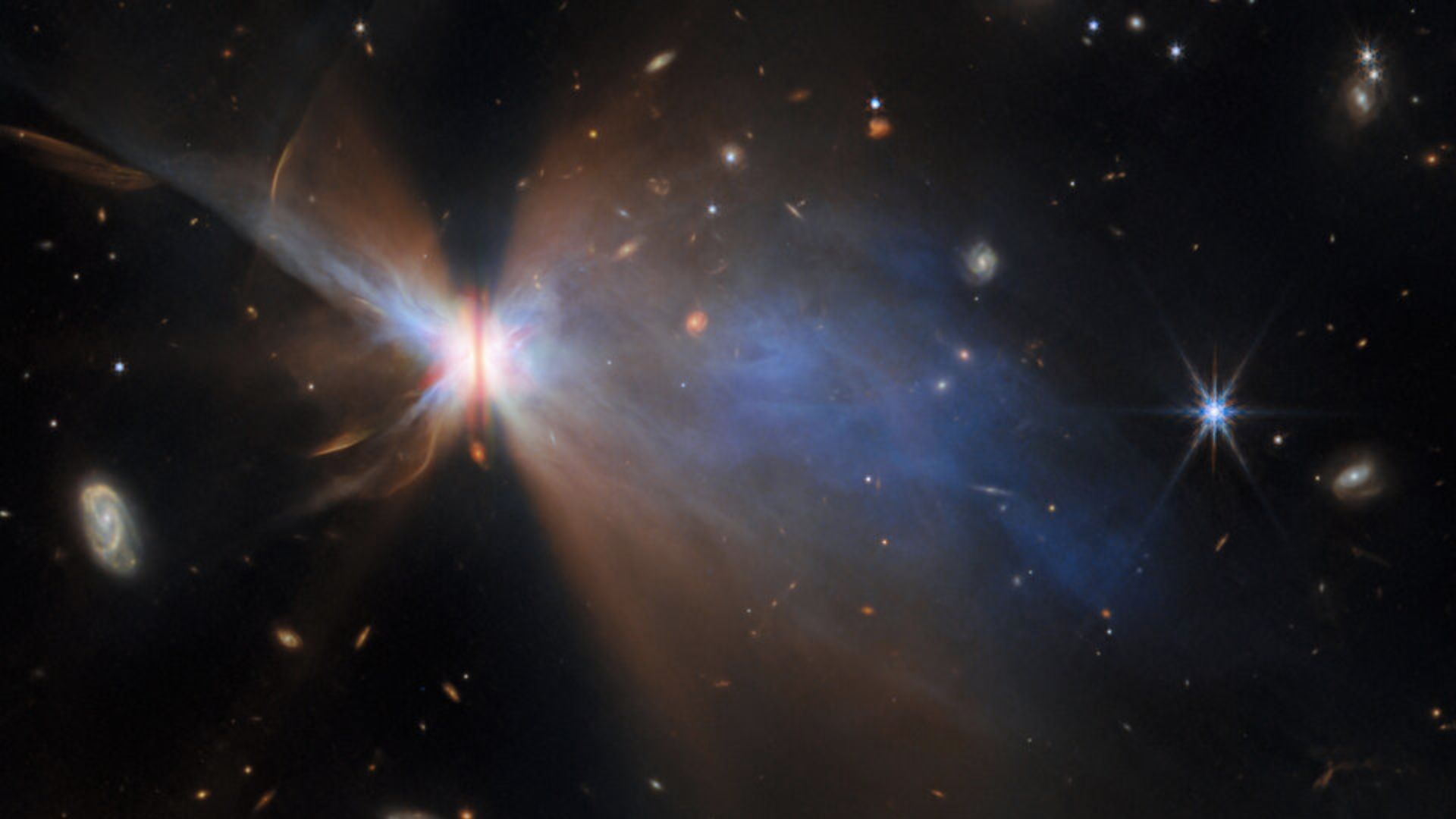
James Webb’s infrared eyes uncover Butterfly Star’s dusty birthplace
When you think about how our own Earth formed billions of years ago, the picture is still a mystery filled with many many gaps. Astronomers know that stars are born in giant clouds of gas and dust, and that planets come from the swirling disks left behind.
However, looking deep into these swirling cradles of planet formation has always been tricky. Dust hides what lies inside, and even the most powerful telescopes until recently struggled to uncover the fine details.
Now, NASA’s James Webb Space Telescope (JWST), working together with the Hubble Space Telescope, has provided a breathtaking new look at IRAS 04302+2247, also called the Butterfly Star.
About 525 light-years away in the Taurus star-forming region, this young protostar is surrounded by a massive protoplanetary disk stretching 65 billion kilometers across, several times wider than our solar system.
Webb’s detailed images of such disks are helping researchers understand how dust evolves into planets, giving them valuable insights about what happened 4.5 billion years ago when our own solar system took shape.
Capturing the butterfly star
To study this stellar nursery, astronomers used Webb’s Near-Infrared Camera (NIRCam) and Mid-Infrared Instrument (MIRI), combined with Hubble’s optical observations. Together, they captured IRAS 04302’s disk in extraordinary detail.
The disk is oriented edge-on from our point of view, which means Webb sees it as a thin dark band blocking the bright light of the growing star at the center.
Instead of rings and spirals (which we notice when disks are viewed face-on), this angle reveals the disk’s vertical structure, its thickness, and how dust grains are settling toward the midplane. This settling process is critical because it allows grains to clump together and grow into the building blocks of planets.
“The thickness of the disc is a measure of how efficient this process has been,” the ESA team notes.
What makes the Butterfly Star so striking are the two luminous wings of nebulous gas and dust that appear on either side of the disk. These reflection nebulae shine because light from the protostar bounces off them, creating the butterfly-like shape.
The dark streak across the middle is actually the dense lane of dusty gas that cocoons the young star, making it easier for Webb to detect the faint features around it. Hubble, on its part, highlights clumps and streaks near the dust lane, showing that the star is still actively feeding on material from its surroundings while also releasing jets and outflows.
“Together, these powerful facilities paint a fascinating multiwavelength portrait of a planetary birthplace,” the ESA team added. They have declared the new view of the IRAS 04302+2247 Picture of the Month.
Protoplanetary disks are of great significance
The project is a part of Webb’s GO program #2562, which focuses on four protoplanetary disks that happen to be aligned edge-on, providing a unique chance to measure how efficiently dust is growing and settling in these environments.
Webb’s sharp infrared vision is crucial here, as it reveals the distribution of very small dust grains and traces light scattering far away from the disk. By mapping the Butterfly Star’s protoplanetary disk in such detail, astronomers are piecing together one of the most important puzzles in planetary science. i.e., how simple dust and gas turn into planets.
Understanding this process doesn’t just explain our own origins, it helps scientists predict how common Earth-like worlds might be around other stars.
Moreover, this achievement also highlights the importance of looking at disks from multiple angles. While face-on views show structures like rings and gaps, the edge-on views expose how dust settles vertically. Both perspectives are needed to build a complete picture.
The next goal of the researchers is to expand their survey to more protoplanetary disks, using Webb’s sensitivity to track dust growth at different stages.
Continue Reading
-
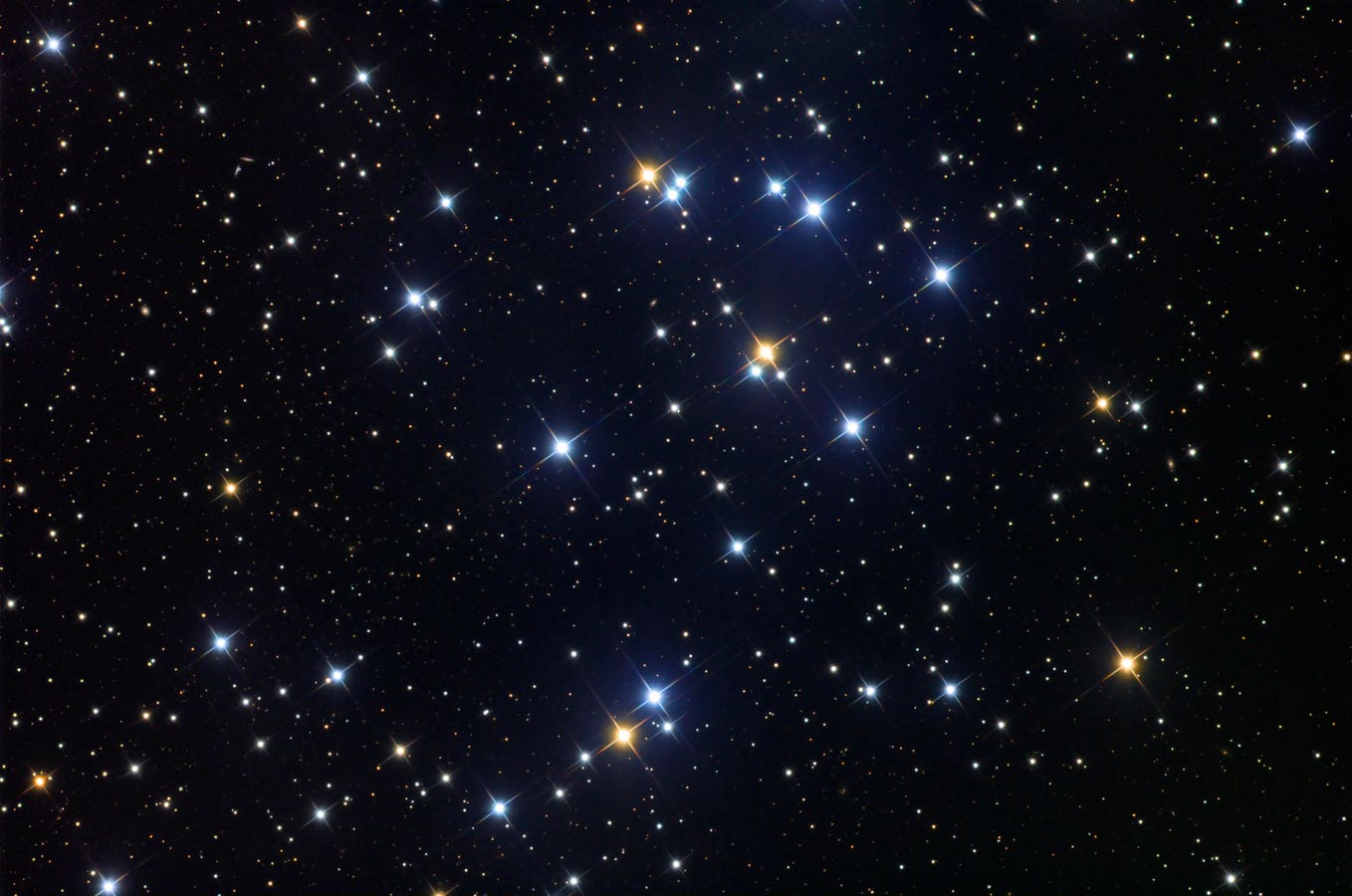
When To See Venus Dance With A Beehive Of Stars On Monday
The Beehive Cluster is an open cluster in the constellation Cancer. It is one of the nearest open clusters to the Solar System, and it contains a larger star population than most other nearby clusters.
getty
Skywatchers brave enough to get up early on Monday morning will get the rare sight of a bright Venus close to one of the most beautiful open clusters of stars in the night sky. Earth’s sister planet will dominate the pre-dawn night sky, with the Beehive Cluster — also called M44 — visible in the same field of view in a pair of binoculars. Here’s how to see them together.
Where And When To Look
On Sunday, Aug. 31, be outside about 90 minutes before sunrise, facing east. In a clear sky, you’ll see Venus — now 84%-lit, as seen through a telescope — shine as by far the brightest object in that part of the sky (-3.8 magnitude). Close to its lower-right will be the Beehive Cluster, easily visible through binoculars.
Although Venus will shine brightly until sunrise, the Beehive Cluster will disappear from view as dawn breaks, so don’t delay — you need to see this match-up in darkness.
What You’ll See
If you’ve not seen Venus for a while, it’s worth admiring in the pre-dawn sky — particularly because it’s now past its best and will continue to shrink and lessen in brightness for the rest of the year. It will dominate the night sky, yet it’s rare for it to get so close to the Beehive Cluster, which, by contrast, will be a more tenuous sight. It’s in the faint constellation Cancer, between two bright stars — Regulus in Leo and Pollux in Gemini — and a pale yet dense cloud of stars.
Monday’s rare meeting of Venus and the Beehive Cluster will be worth getting up for — if you bring binoculars.
Stellarium
Observing Tips
While Venus is best seen with the naked eye (it’s only worth seeing in a telescope when it’s a slim crescent), the Beehive Cluster is one of the main reasons why experienced stargazers prioritise binoculars, not telescopes. Use any pair for this duo, placing them below and to the left of Venus, preferably when the sky is dark, before dawn strikes.
What’s Next In The Night Sky
A five-planet “parade” is happening in the east an hour before sunrise this week. It’s dominated by Jupiter and Venus, with Saturn in the south, all three of which are visible to the naked eye. Neptune (close to Saturn) and Uranus require a telescope to see.
Although the Beehive Cluster becomes a fabulous binocular object in spring evenings, its next conjunction comes on Oct. 5, 2026, when a crescent moon will pass through it in the east before dawn.
For exact timings, use a sunrise and sunset calculator for where you are, Stellarium Web for a sky chart and Night Sky Tonight: Visible Planets at Your Location for positions and rise/set times for planets.
Wishing you clear skies and wide eyes.
Continue Reading
-

A Rare Cosmic Explosion Reveals a Naked Star
Stars begin their lives by fusing hydrogen atoms into helium, releasing energy that keeps them shining. As they age, the helium produced becomes fuel for the next stage of fusion, resulting in the creation of heavier elements. This process builds up layers inside the star, with hydrogen on the outside and increasingly heavier elements deeper within, such as helium, carbon, oxygen, as well as neon, magnesium, and silicon-sulfur.
Eventually, the star starts fusing silicon and sulfur into iron. But iron doesn’t produce energy through fusion, so when it builds up in the core, the star can no longer support itself. This leads to the collapse of the core, resulting in either a supernova explosion or the formation of a black hole.
Some stars lose their outer hydrogen layers before they explode. These “stripped stars” reveal their inner layers, including helium, carbon, and oxygen, providing scientists with clues about how stars are structured and how they produce different elements.
Supernovae from these stripped stars, especially when surrounded by material they shed earlier, support this layered model. However, direct evidence of the deepest layers, where elements heavier than oxygen are made, has been hard to find.
Large galaxies strip star-forming gases from their small satellite galaxies
In a remarkable new study, astronomers from Stockholm University have helped uncover a cosmic rarity: a supernova that exploded without the usual ingredients. Named SN 2021yfj, this stellar event was born from a star that had shed its outer layers, leaving behind only its oxygen-, silicon-, and sulfur-rich core—a configuration never observed so clearly before.
The explosion lit up the constellation Cetus in September 2021, and despite its distance of 2 billion light-years, it was bright enough to catch the attention of telescopes around the world.
What makes SN 2021yfj so extraordinary is that it lacked hydrogen, helium, carbon, and oxygen, the most common elements in the Universe. Instead, it exposed the deepest fusion layers of a massive star, offering direct evidence of the shell-like structure scientists have long theorized.
Steve Schulze, who led the study, said, “This is the first time we have seen a star that was essentially stripped to the bone. It shows us how stars are structured and proves that stars can lose a lot of material before they explode.”
Study precisely estimates the abundance of Helium in our Sun
Jesper Sollerman, professor at the Department of Astronomy at Stockholm University, is one of the co-investigators of the study:
“Most of the Universe is made up of hydrogen and helium, but we have previously found exploding stars that are stripped of these elements and instead contain mostly carbon, oxygen, and nitrogen. However, SN 2021yfj contains instead the even rarer elements: silicon and sulphur. These are known to be produced in the very innermost cores of massive stars, but we have never before seen the evidence of this in such a clear way.”
Astronomers observed a thick shell of silicon and sulfur that was thrown off by a dying star just before it exploded as a supernova. Seeing this deep layer is extremely rare; it means the star has unusually lost its outer layers. This event revealed advanced stages of stellar evolution, where heavier elements like silicon, sulfur, and argon are formed. These elements are typically hidden deep within and are rarely visible on the surface of massive stars.
To study this rare explosion, scientists around the world used some of the biggest telescopes, including Keck in Hawai‘i, the Very Large Telescope in Chile, and the Nordic Optical Telescope in La Palma, collecting data for nearly two months.
Journal Reference:
- Schulze, S., Gal-Yam, A., Dessart, L. et al. Extremely stripped supernova reveals a silicon and sulfur formation site. Nature 644, 634–639 (2025). DOI: 10.1038/s41586-025-09375-3
Continue Reading
-
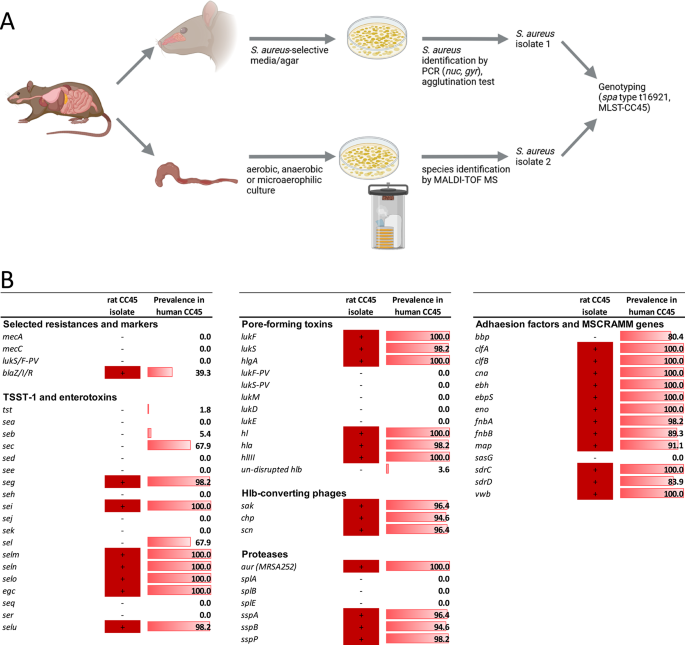
Application of a comprehensive approach to pathogen screening in a stowaway rat on an airplane
Sample collection, dissection and species identification
All methods were carried out in accordance with relevant national and international guidelines and regulations. The removal of the stowaway rat from the airplane follows the regulations given by the International Air Transport Association (IATA) and the World Health Organization (WHO; World Health Organization 2015). According to the American Veterinary Medical Association (AVMA), Guidelines for the Euthanasia of Animals (2020), the employed euthanasia method for the stowaway rat is consistent with the commonly accepted norms of veterinary best practice.
On March 24 in 2017, a rodent was spotted on an airplane from Miami (Florida, USA) to Berlin (Germany) that started its journey in Dubai (UAE). In accordance with international regulations, the aviation authority grounded the airplane at Berlin-Tegel airport. After internal fumigation of the whole airplane with CO2 gas, the rat (H17/01) was located (with the help of a hunting dog) and collected for further investigations. The rodent capture and subsequent investigation workflows are shown in Figure S1.
The animal was frozen and sent to the Friedrich-Loeffler-Institut (FLI), Greifswald-Insel Riems, for necropsy and coordination of pathogen screening. The frozen carcass was thawed at 4 °C and dissected in a biosafety level 3 containment laboratory, with corresponding hygiene measures for the personnel, following a standard protocol, i.e. samples were taken from the heart, lung, chest cavity fluid (CCF), brain, liver, spleen, kidney, trachea, tongue, nose, ear, intestine, feces and the tail tip, then stored at -20 °C. Weight, sex, body and tail lengths were documented during dissection.
The rat species was determined by cytochrome b gene sequencing, as previously described25. Additionally, the entire cytochrome b gene and the whole mitochondrial genome of the rat was extracted from HTS datasets via reference mapping and phylogenetically analyzed (see below).
Microbial isolation, cultivation and pathogen characterization
To demonstrate reproducibility, two cultivation trials were performed for bacterial and fungal organisms at different institutions (FLI and University Medical Center Göttingen (UMG)). In a first trial, cultivation of fecal samples was initiated with a bacteriological plate set consisting of cattle blood Columbia agar plates (Sifin, Berlin, Germany) under aerobic and anaerobic incubation conditions, as well as an aerobic incubation on a Gassner plate (Water blue Metachrome yellow agar according to Gassner, modified, Sifin), all at 37 °C. For Salmonella exclusion diagnostics, Rappaport medium (Rappaport-Vassiliadis soy peptone (RVS) broth, Oxoid, Wesel, Germany), and an XLD (xylose lysin desoxycholat agar (XLD agar), Carl Roth, Karlsruhe, Germany) plate were used.
In a second trial, rat fecal samples were incubated in three different atmospheres: (I) Aerobic conditions, at 37 °C: Columbia agar supplemented with 5% sheep blood (Becton Dickinson GmbH, Heidelberg, Germany), Salmonella Shigella agar (Becton Dickinson GmbH), MacConkey agar no. 3 (Thermo Fisher Scientific Inc., Waltham, MA, USA), Sabouraud dextrose agar (Thermo Fisher Scientific Inc.), Chapman/Mannitol salt agar (Becton Dickinson GmbH), and Yersinia selective agar (Becton Dickinson GmbH), (II) Microaerophilic (CampyGen sachets, Thermo Scientific Oxoid) or capnophilic (BD BBL™ CO2 generators, Becton Dickinson GmbH) conditions at 37 °C: Campylosel agar (bioMérieux, Nürtingen, Germany) and Mueller Hinton Chocolate agar (Becton Dickinson GmbH), (III) Anaerobic conditions (BD BBL GasPak™ Plus, Becton Dickinson GmbH) for 2 to 14 days at 37 °C: chromID™ C. difficile agar (bioMérieux, Nürtingen, Germany), Schaedler agar with vitamin K1 and 5% sheep blood (Becton Dickinson GmbH), and Schaedler kanamycin-vancomycin agar with 5% sheep blood (Becton Dickinson GmbH).
For detection of Acinetobacter baumannii, tracheal sample material was suspended in 3 mL of mineral medium26 supplemented with 0.1% acetate as the sole source of carbon and energy, and incubated at 37 °C with constant shaking27. After zero, five, and 24 h, respectively, 100 µL of the suspension were spread onto Acinetobacter selective medium (CHROMagar, La Plaine St-Denis, France; without CHROMagar multidrug-resistant supplement) and incubated for 24 h at 37 °C.
Isolation and characterization of Staphylococcus aureus
As illustrated in Fig. 1, S. aureus was isolated from the homogenized rat nose in a culture-based approach, as previously reported28. Furthermore, S. aureus was isolated from rat intestine content (feces) by streaking a pea-sized amount of the feces sample onto a Columbia sheep blood agar plate using the quadrant streaking technique. The plate was then incubated overnight under aerobic conditions at 37 °C.
Fig. 1 Nasal and gastrointestinal colonization of the airplane rat with a CC45-MSSA strain. Staphylococcus (S.) aureus was isolated from the nose using selective agars and media, and identified by an S. aureus-specific latex agglutination test as well as an S. aureus-specific multiplex PCR. Colon content was streaked onto a set of different selective media including Chapman mannitol salt agar on which a second S. aureus isolate could be cultured. Microbial species identification by MALDI-TOF MS was performed using a Bruker Autoflex III system. S. aureus isolates from nose and colon both belonged to spa type t16921 (CC45) (A). Staphylococcal resistance, virulence and immune evasion genes were detected with a commercial DNA array. The presence of CC45-associated genes in the nasal rat CC45-MSSA isolate vs. 56 human CC45-MSSA isolates is depicted (B).
S. aureus identity was confirmed with a colony multiplex-PCR for the S. aureus gyrase gene and an S. aureus-specific latex agglutination test (Staph Xtra Latex kit, ProLex, Richmond Hill, ON, Canada), as previously reported28.
Spa genotyping and multilocus sequence typing (MLST) were performed as previously described29,30. Virulence and resistance genes were detected with the StaphID DNA microarray (Alere Technologies GmbH, Jena, Germany)28,31. The mecC gene encoding a methicillin resistance gene product was detected by PCR, as previously described32. Human nasal clonal complex (CC) 45 isolates (n = 56), which were obtained in the population-based study SHIP-TREND-1 between 2016 and 201933 (approval number BB 39/08 by the Ethics Committee at the University Medicine Greifswald, Germany) by culture-based approaches as previously reported34, were used for the comparison of samples in our study.
Whole-genome sequencing, genome reconstruction and annotation, and phylogenetic analysis of Staphylococcus aureus isolates
Whole-genome sequencing (WGS) was conducted following an established protocol35. In brief, genomic DNA was extracted from both cecum and nasal isolates, and subjected to initial paired-end (2 × 150 base pairs, bp) next generation sequencing using an Illumina MiSeq platform. Long-read sequencing was subsequently performed on the Oxford Nanopore Technologies (ONT) platform and combined with the Illumina data for genomic reconstruction. For this, long-read sequences were assembled using the flye software (v2.9.2-b1786)36. Next, short-read polishing of the assemblies was performed via the HyPo package (v1.0.3; https://github.com/kensung-lab/hypo). Species-specific annotation was subsequently conducted through Bakta (v1.10.0)37. MLST was performed using mlst (v2.23.0) (https://github.com/tseemann/mlst). Circular genomes were visualized using GenoVi (v0.4.3)38. Single nucleotide polymorphisms (SNP) between both isolates were assessed using snippy (v4.6.0) (https://github.com/tseemann/snippy). Plasmid sequences were further investigated via PlasmidFinder (v2.1)39.
In order to assess the phylogenetic relationship of the isolates within the context of publicly available data, a total of 1,689 genomes assigned to sequence type 45 (ST45) were retrieved from Pathogenwatch (dated 2024-11-16) (https://pathogen.watch/). When available, metadata regarding geographical and temporal distribution were also included. The genome collection was annotated analogously to the sequenced isolates, and both were utilized for further population study. The population structure of the sample collection was investigated through phylogenetic reconstruction of a maximum-likelihood tree. A gene-by-gene approach was selected to first establish a shared set of conserved (“core”) genes based on the annotated bacterial assemblies in combination with the roary software (v3.13.0)40. Using this approach, a total of 1,528 conserved genes were identified, which were present in at least 99% of the strains (protein sequence similarity ≥ 95%, sequence coverage ≥ 90%). This was followed by gene-wise alignments using the MAFFT software (v7.520)41, and subsequent concatenation of the alleles per sample. The resulting alignment was then utilized to infer a phylogeny through RAxML-NG (v1.2.0)42 using a General Time Reversible (GTR) model and gamma correction for rate variation among sites. Finally, iTOL (v6.8.1)43 was used to visualize the isolates within the context of the available genomes of the corresponding CC. Average nucleotide identity (ANI) values were computed between the isolates and the genome collection through fastANI (v1.34)44. The presence of mecA was assessed through ABRicate (v1.0.1) (https://github.com/tseemann/abricate) using the National Center for Biotechnology Information (NCBI) antimicrobial resistance (AMR) database (dated 2025-01-14) with default settings (minimum coverage and identity ≥ 80%).
Nucleic acid extraction and RT-PCR and PCR investigations
For pathogen specific nucleic acid detection, standard protocols for RNA and DNA extraction were used (Table S1). The extracted nucleic acids were stored at − 80 °C until further use.
Generic and pathogen-specific conventional and real-time RT-PCR and PCR investigations for 20 viruses, ten bacteria and one endoparasite followed established standard protocols (Table S1). For the detection of polyoma and papilloma viruses, enrichment of potential circular viral DNA, in the background of linear host DNA, was performed via rolling circle amplification (RCA) using the TempliPhi RCA kit (GE Healthcare, Piscataway, NJ, USA), as previously described45.
The species identification of the yeast, Cutaneotrichosporon mucoides, was conducted via 18S ribosomal RNA (rRNA) gene sequencing using a previously published protocol46.
Matrix-assisted laser desorption/ionisation time-of-flight mass spectrometry (MALDI-TOF MS) identification of bacterial and fungal species
The species of morphologically distinct colonies were identified using the Bruker Biotyper MALDI-TOF MS system (Bruker Daltonics GmbH & Co. KG, Bremen, Germany) using the ethanol/formic acid extraction method following the recommended standard procedure47. Thereafter, one µL of the supernatant was spotted onto polished steel MALDI target plates. The air-dried whole cell extracts were overlaid with 2 µL of a saturated solution of α-cyano-4-hydroxycinnamic acid in 50% acetonitrile / 2.5% trifluoroacetic acid and dried again at ambient temperature. Spectra were acquired with an Autoflex III and Ultraflextreme mass spectrometer (Bruker) in the linear positive mode, in the mass range of 2,000–20,000 Da. The instrument was externally calibrated in the mass range between 3,637.8 and 16,952.3 Da using the Bacterial Test Standard (BTS) calibrant (Bruker Daltonics, Bremen, Germany) before measurement. Samples were identified using the MALDI Biotyper software (version 3.1) together with the Bruker reference library (database release 2017). Results with MALDI Biotyper identification scores greater than 2.000 were deemed sufficient for species identification48,49,50,51. For the mass spectrometric species identification of fungi, the established method for bacteria was expanded through an extended direct transfer (eDT) approach. In this process, after applying the sample to the MALDI target plate, an on-target lysis (OTL) was performed using one µL of 70% formic acid. Following the evaporation of the formic acid, the matrix solution was applied.
Metagenomics analyses
Ion Torrent S5 compatible libraries of liver (L2208), spleen (L2209), lung (L2210), feces (L2211), CCF (L2212), brain (L2213), and kidney (L2214) were prepared according to Wylezich et al. 201852. Sequencing was performed on an Ion Torrent platform (either PGM or S5XL) using a suitable chip with a mean read length of 400 bp. Metagenomic analyses were conducted by the use of the RIEMS pipeline53. In addition to RIEMS, DIAMOND was used to screen for additional picobirnavirus (PBV) hits54. The PBV consensus sequences were determined by an iterative assembly and mapping approach through the Genome Sequencer software suite (v3.0; Roche), after extraction of the PBV reads from the datasets using RIEMS and DIAMOND. Nucleotide sequences were in-silico translated into protein sequences with EMBOSS version 6.3.155. For comparison, two metagenome datasets originating from Norway rat feces in Berlin, Germany, from the Sequence Read Archive (SRR1438008, library Mu/10/1772; SRR1438014, library Mu/10/1805) were used for viral genome assembly, because of the high number of PBV reads identified by Sachsenröder et al. 201418. PBV reads were identified in the datasets using DIAMOND, extracted and assembled using SPAdes (version 3.13.1)56.
Prokaryotic and eukaryotic suspected taxa, according to the RIEMS results protocols, were verified via reference mapping (Genome Sequencer software suite, versions 2.6; Roche) using small subunit rRNA sequences as described57. Afterwards, datasets were again mapped against the obtained contigs of the nearly complete 16S/18S rRNA gene sequences using different identity thresholds (-mi 95, 98, 100). The following sequences were used as references: the bacteria Acinetobacter baumannii strain ATCC 19606T (NR_117620), Anaplasma phagocytophilum strain Webster (NR_044762), Bartonella grahamii (HG726044), Bartonella henselae strain Houston-1 (NR_074335.2), Borrelia burgdorferi strain G2 (M60967), Clostridioides difficile ATCC 9689/DSM 1296 (NR_112172), Leptospira ainlahdjerensis strain 201903070 (NR_181724), Metamycoplasma/ Mycoplasma arthritidis strain PG6 T (M24580.2), Mycoplasmopsis pulmonis strain PG34 (NR_041744), Rickettsia japonica YH (NR_074459.2), Rodentibacter pneumotropicus strain NCTC 8141 (NR_118763), Streptobacillus moniliformis strain DSM 12112T (NR_074449), the fungi Cystobasidium laryngis (AB126649) and Trichosporon mucoides (AB001763.2), and the protists Babesia microti strain RI (XR_002459986) and Goussia bayae isolate Potomac (MH758783).
Bioinformatic and phylogenetic analyses
For phylogenetic analysis of PBV sequences, we used the amino acid sequence of the RNA-dependent RNA polymerase (RdRp) encoded by the segment 2 according to Yinda et al. (2018)58. Sequence alignments were conducted with MAFFT59, as implemented in Geneious Prime 10.2.3 (Biomatters, Auckland, New Zealand). A phylogenetic maximum-likelihood tree was constructed using RAxML 8.2.1160, implemented in Geneious Prime 10.2.3 using default settings and 100 bootstrap replications.
The complete mitochondrial genome of the rat was extracted from HTS datasets (L2208, L2210, L2211, L2213, L2214) using NC_012374 (Rattus rattus) as reference sequence. The obtained sequence was aligned with mitochondrial sequences of the genus Rattus, retrieved from GenBank. A maximum-likelihood phylogenetic tree was constructed using PhyML version 3.061 using the Generalized Time Reversible (GTR) nucleotide substitution model with a gamma distribution and a proportion of invariable sites, and 1,000 bootstrap replications within the Geneious Prime 10.2.3 software package. The best-fit nucleotide substitution model was determined by J Model Test262. In parallel, a Bayesian analysis was performed in MrBayes version 3.2.663 for 50 million generations, sampled every 5,000 generations and the first 25% were discarded as burn-in.
Multiplex serology
The multiplex serology “rat panel” included rat parvoviruses (Kilham rat virus, Toolan´s H-1 virus and rat minute virus, species Protoparvovirus rodent 1; rat parvovirus, species Protoparvovirus rodent 2), Sendai virus (species Respirovirus muris), rat coronavirus (species Betacoronavirus muris), pneumonia virus of mice (species Murine orthopneumovirus), mouse adenovirus type 1 (species Mastadenovirus encephalomyelitidis), cowpox virus (species Orthopoxvirus cowpox), orthohantaviruses including Seoul orthohantavirus (species Orthohantavirus seoulense), reovirus type 3 (species Orthoreovirus mammalis), rat hepatitis E virus (species Rocahepevirus ratti), rat rotavirus (species Rotavirus betagastroenteritidis), Streptobacillus moniliformis, Rodentibacter spp., Mycoplasma pulmonis and Mycoplasma arthritidis. Except for the detection of antibodies against the bacteria mentioned above, the multiplex serology was based on a glutathione-S-transferase (GST) capture immunosorbent assay in combination with the fluorescent bead technology from Luminex Corp. (Austin, TX, USA). Viral antigens were expressed as GST-tagged fusion proteins and affinity-purified directly on glutathione-casein-coupled polystyrene beads with distinct embedded fluorescent dyes (SeroMap; Luminex Corp.), as previously described64. In contrast, bacteria were cultured, lysed and membrane proteins were extracted, before they were directly coupled to polystyrene beads. The general set-up and protocol of the multiplex serology was described by Schmidt et al. 201765. The Luminex analyzer BioPlex200 (BioRad Laboratories GmbH, Munich, Germany) was used to distinguish between the bead sets, and consequently the bound antigen, and to quantify the amount of bound serum antibody using a secondary antibody (biotinylated goat anti-rat IgM/IgG, Jackson ImmunoResearch Laboratories, Inc., West Grove, PA, USA; diluted 1:1,000) and a fluorescent reporter conjugate (streptavidin-R-phycoerythrin). Final antigen-specific median fluorescence intensity (MFI) values were measured for at least 75 beads per bead set, and sample and net values were calculated by subtracting the individual bead background values resulting from a serum-free reaction and from a bead-set loaded with GST-tag only. Samples were defined as positive if the net MFI values were above the calculated cut-off to achieve 98% specificity for seropositivity to the individual antigens on the basis of the receiver operating characteristics (ROC) during the validation process.
Continue Reading